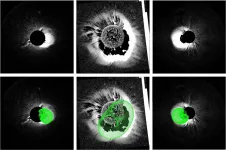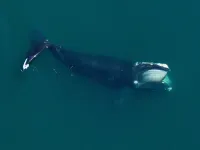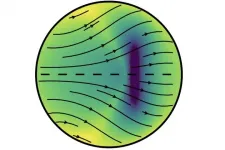(Press-News.org) The surface of the sun churns with energy and frequently ejects masses of highly-magnetized plasma towards Earth. Sometimes these ejections are strong enough to crash through the magnetosphere -- the natural magnetic shield that protects the Earth -- damaging satellites or electrical grids. Such space weather events can be catastrophic.
Astronomers have studied the sun's activity for centuries with greater and greater understanding. Today, computers are central to the quest to understand the sun's behavior and its role in space weather events.
The bipartisan PROSWIFT (Promoting Research and Observations of Space Weather to Improve the Forecasting of Tomorrow) Act [https://www.govinfo.gov/content/pkg/BILLS-116s881enr/pdf/BILLS-116s881enr.pdf], passed into law in October 2020, is formalizing the need to develop better space weather forecasting tools.
"Space weather requires a real-time product so we can predict impacts before an event, not just afterward," explained Nikolai Pogorelov, distinguished professor of Space Science at The University of Alabama in Huntsville, who has been using computers to study space weather for decades. "This subject - related to national space programs, environmental, and other issues - was recently escalated to a higher level."
To many, space weather may seem like a distant concern, but like a pandemic -- something we knew was possible and catastrophic -- we may not realize its dangers until it's too late.
"We don't think about it, but electrical communication, GPS, and everyday gadgets can be effected by extreme space weather effects," Pogorelov said.
Furthermore, the U.S. is planning missions to other planets and the moon. All will require very accurate predictions of space weather - for the design of spacecraft and to alert astronauts to extreme events.
With funding from the National Science Foundation (NSF) and NASA, Pogorelov leads a team working to improve the state-of-the-art in space weather forecasting.
"This research, blending intricate science, advanced computing and exciting observations, will advance our understanding of how the Sun drives space weather and its effects on Earth," said Mangala Sharma, Program Director for Space Weather in the Division of Atmospheric and Geospace Sciences at NSF. "The work will help scientists predict space weather events and build our nation's resilience against these potential natural hazards."
The multi-institutional effort involves the Goddard and Marshall Space Flight Centers, Lawrence Berkeley National Laboratory, and two private companies, Predictive Science Inc. and Space Systems Research Corporation.
Pogorelov uses the Frontera supercomputer at the Texas Advanced Computing Center (TACC) -- the ninth fastest in the world -- as well as high performance systems at NASA and the San Diego Supercomputing Center, to improve the models and methods at the heart of space weather forecasting.
Turbulence plays a key role in the dynamics of the solar wind and coronal mass ejections. This complex phenomenon has many facets, including the role of shock-turbulence interaction and ion acceleration.
"Solar plasma is not in thermal equilibrium. This creates interesting features," Pogorelov said.
Writing in the Astrophysical Journal [https://iopscience.iop.org/article/10.3847/1538-4357/abe62c/meta] in April 2021, Pogorelov, along with Michael Gedalin (Ben Gurion University of the Negev, Israel), and Vadim Roytershteyn (Space Science Institute) described the role of backstreaming pickup ions in the acceleration of charged particles in the universe. Backstreaming ions, either of interstellar or local origin, are picked up by the magnetized solar wind plasma and move radially outwards from the Sun.
"Some non-thermal particles can be further accelerated to create solar energetic particles that are particularly important for space weather conditions on Earth and for people in space," he said.
Pogorelov performed simulations on Frontera to better understand this phenomenon and compare it with observations from Voyager 1 and 2, the spacecraft that explored the outer reaches of the heliosphere and are now providing unique data from the local interstellar medium.
One of the major focuses of space weather prediction is correctly forecasting the arrival of coronal mass ejections -- the release of plasma and accompanying magnetic field from the solar corona -- and determining the direction of the magnetic field it carries with it. Pogorelov's team's study of backstreaming ions help to do so, as does work published in the Astrophysical Journal in 2020 that used a flux rope-based magnetohydrodynamic model to predict the arrival time to Earth and magnetic field configuration of the July 12, 2012 coronal mass ejection. (Magnetohydrodynamics refers the magnetic properties and behavior of electrically conducting fluids like plasma, which plays a key role in dynamics of space weather).
"Fifteen years ago, we didn't know that much about the interstellar medium or solar wind properties," Pogorelov said. "We have so many observations available today, which allow us to validate our codes and make them much more reliable."
Pogorelov is a co-investigator on an on-board component of the Parker Solar Probe called SWEAP (Solar Wind Electrons, Protons, and Alphas instrument) [http://sweap.cfa.harvard.edu/]. With each orbit, the probe approaches the sun, providing new information about the characteristics of the solar wind.
"Soon it will penetrate beyond the critical sphere where the solar wind becomes superfast magnetosonic, and we'll have information on the physics of solar wind acceleration and transport that we never had before," he said.
As the probe and other new observational tools become available, Pogorelov anticipates a wealth of new data that can inform and drive the development of new models relevant to space weather forecasting. For that reason, alongside his basic research, Pogorelov is developing a software framework that is flexible, useable by different research groups around the world, and can integrate new observational data.
"No doubt, in years to come, the quality of data from the photosphere and solar corona will be improved dramatically, both because of new data available and new, more sophisticated ways to work with data," he said. "We're trying to build software in a way that if a user comes up with better boundary conditions from new science missions, it will be easier for them to integrate that information."
INFORMATION:
References:
Singh, T., Kim, T. K., Pogorelov, N. V., & Arge, C. N. (2020). Application of a modified spheromak model to simulations of coronal mass ejection in the inner heliosphere. Space Weather, 18, e2019SW002405. https://doi.org/10.1029/2019SW002405
Singh, T., Yalim, M. S., Pogorelov, N. V., and Gopalswamy, N., A Modified Spheromak Model Suitable for Coronal Mass Ejection Simulations, The Astrophysical Journal, vol. 894, no. 1, 2020. doi:10.3847/1538-4357/ab845f.
MADISON, Wis. -- For birds and other wildlife, winter is a time of resource scarcity. Extreme winter weather events such as a polar vortex can push some species to the edge of survival. Yet winter tends to get short shrift in climate change research, according to UW-Madison forest and wildlife ecology Professor Ben Zuckerberg.
"When we think about the impact of climate change, winter tends to be overlooked as a time of year that could have significant ecological and biological implications," says Zuckerberg. "It makes me, and my colleagues, think quite deeply about the impacts of these extreme events during this time when species are particularly vulnerable."
Zuckerberg, ...
Using a piece of magnet, researchers have designed a simple system that can control the movement of a small puddle of water, even when it's upside down. The new liquid manipulation strategy, described in the journal Cell Reports Physical Science on June 3, can have a wide range of applications including cleaning hard-to-reach environments or delivering small objects.
Previous attempts to control the movement of fluids often relied on special platforms. For example, on a surface that has one section more hydrophobic than another, water will spontaneously ...
Anyone that's ever interacted with a dog knows that they often have an amazing capacity to interact with people. Now researchers reporting in the journal Current Biology on June 3 have found that this ability is present in dogs from a very young age and doesn't require much, if any, prior experience or training. But, some of them start off better at it than others based on their genetics.
"We show that puppies will reciprocate human social gaze and successfully use information given by a human in a social context from a very young age and prior to extensive experience with humans," said Emily E. Bray of the University of Arizona, Tucson. "For example, even before puppies have left their littermates to live ...
Whales are largely protected from direct catch, but many populations' numbers still remain far below what they once were. A study published in the journal Current Biology on June 3 suggests that, in addition to smaller population sizes, those whales that survive are struggling. As evidence, they find that right whales living in the North Atlantic today are significantly shorter than those born 30 to 40 years ago.
"On average, a whale born today is expected to reach a total length about a meter shorter than a whale born in 1980," said Joshua Stewart of the National Oceanic and Atmospheric Administration (NOAA) in La Jolla, CA. That represents an average decline in length of about 7%. "But that's just the average--there are also some extreme cases where young whales are several ...
Patients who, perhaps unbeknownst to their health care providers, are in need of genetic testing for rare undiagnosed diseases can be identified en masse based on routine information in electronic health records (EHRs), a research team reported today in the journal Nature Medicine.
Findings from the Vanderbilt University Medical Center study suggest that, among the patients of any sizeable health care system, there are hundreds or thousands with undiagnosed rare diseases of the sort where a genetic test could lead to a diagnosis.
"Patients with rare genetic diseases often face ...
What The Study Did: Changes in pregnancy and birth rates before and after COVID-19 lockdown measures were estimated using electronic medical records.
Authors: Molly J. Stout, M.D., of the University of Michigan in Ann Arbor, is the corresponding author.
To access the embargoed study: Visit our For The Media website at this link https://media.jamanetwork.com/
(doi:10.1001/jamanetworkopen.2021.11621)
Editor's Note: Please see the article for additional information, including other authors, author contributions and affiliations, conflict of interest and financial disclosures, and funding and support.
INFORMATION:
Media advisory: The full study is linked to this news release.
Embed this link to provide your readers free access ...
Quantum computers with their promises of creating new materials and solving intractable mathematical problems are a dream of many physicists. Now, they are slowly approaching viable realizations in many laboratories all over the world. But there are still enormous challenges to master. A central one is the construction of stable quantum bits - the fundamental unit of quantum computation called qubit for short - that can be networked together.
In a study published in Nature Materials and led by Daniel Jirovec from the Katsaros group at IST Austria in close collaboration with researchers from the L-NESS Inter-university Centre in Como, Italy, scientists now have created a new and promising candidate system for reliable qubits.
Spinning Absence
The researchers created the qubit using the ...
Dogs may have earned the title "man's best friend" because of how good they are at interacting with people. Those social skills may be present shortly after birth rather than learned, a new study by University of Arizona researchers suggests.
Published today in the journal Current Biology, the study also finds that genetics may help explain why some dogs perform better than others on social tasks such as following pointing gestures.
"There was evidence that these sorts of social skills were present in adulthood, but here we find evidence that puppies - sort of like humans - are biologically prepared to interact in these social ways," said lead study author Emily Bray, a postdoctoral research associate in the UArizona School of Anthropology in the College of Social and Behavioral ...
(Toronto, June 3, 2021) -- The impact of deploying Artificial Intelligence (AI) for radiation cancer therapy in a real-world clinical setting has been tested by Princess Margaret researchers in a unique study involving physicians and their patients.
A team of researchers directly compared physician evaluations of radiation treatments generated by an AI machine learning (ML) algorithm to conventional radiation treatments generated by humans.
They found that in the majority of the 100 patients studied, treatments generated using ML were deemed to be clinically acceptable for patient treatments by physicians.
Overall, 89% of ML-generated treatments were considered clinically acceptable for treatments, ...
For reasons unknown, Earth's solid-iron inner core is growing faster on one side than the other, and it has been ever since it started to freeze out from molten iron more than half a billion years ago, according to a new study by seismologists at the University of California, Berkeley.
The faster growth under Indonesia's Banda Sea hasn't left the core lopsided. Gravity evenly distributes the new growth -- iron crystals that form as the molten iron cools -- to maintain a spherical inner core that grows in radius by an average of 1 millimeter per year.
But the enhanced growth on one side suggests that something in Earth's outer core or mantle under Indonesia is removing heat from the inner core at a faster rate than on the opposite side, under Brazil. Quicker cooling on one side would ...







